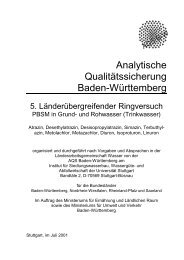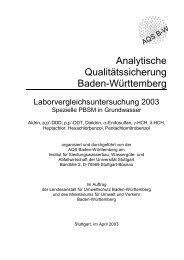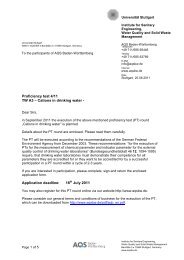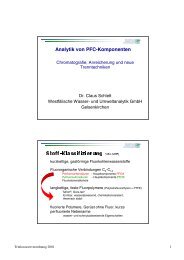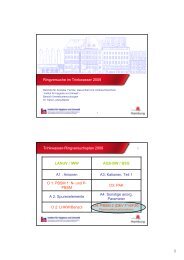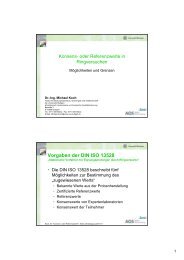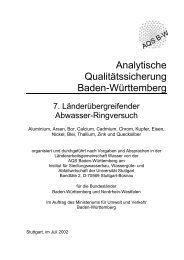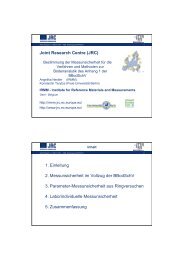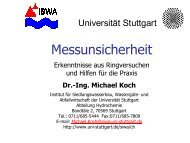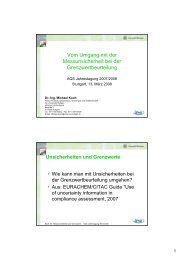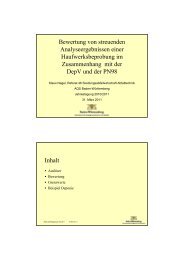Institute for Sanitary Engineering, Water Quality and Solid Waste ...
Institute for Sanitary Engineering, Water Quality and Solid Waste ...
Institute for Sanitary Engineering, Water Quality and Solid Waste ...
Create successful ePaper yourself
Turn your PDF publications into a flip-book with our unique Google optimized e-Paper software.
Chair of <strong>Waste</strong> Management <strong>and</strong> Emissions<br />
The results indicated the presence of the biological<br />
waste in a high percentage, as well as a high quantity<br />
of plastics, paper <strong>and</strong> glass, there<strong>for</strong>e a considerable<br />
potential <strong>for</strong> material <strong>and</strong> energy recovery.<br />
Financed:<br />
Umweltministerium Baden-Württemberg<br />
Project partners:<br />
Universität Stuttgart, Institut für Siedlungswasserbau,<br />
Wassergüte- und Abfallwirtschaft - Lehrstuhl<br />
für Abfallwirtschaft und Abluft; Universitatea Politehnica<br />
„Timisoara“, Facultatea de Hidrotehnica;<br />
Agentia Nationala de Protectie a Mediului; Retim<br />
Ecologic Service SA; Goscom Vaslui SA<br />
Duration:<br />
2008-2009<br />
Contact:<br />
Prof. Dr.-Ing. Martin Kranert<br />
Dr.-Ing. Klaus Fischer<br />
Dipl.-Ing., M.Sc. Mihaela Berechet<br />
Dipl.-Ing. Oliver Schiere<br />
FORWAST: Project full title: Overall mapping of<br />
physical flows <strong>and</strong> stocks of resources to <strong>for</strong>ecast<br />
waste quantities in Europe <strong>and</strong> identify lifecycle<br />
environmental stakes of waste prevention<br />
<strong>and</strong> recycling.<br />
Project summary:<br />
The FORWAST project intends to provide:<br />
• an inventory of the historically cumulated physical<br />
stock of materials in EU-27 (EU-25 plus Romania<br />
<strong>and</strong> Bulgaria), <strong>and</strong> to <strong>for</strong>ecast the expected<br />
amounts of waste generated, per resource category,<br />
in the next 25 years.<br />
• an assessment of the life-cycle wide environmental<br />
impacts from different scenarios of waste prevention,<br />
recycling <strong>and</strong> waste treatment in the EU-<br />
27.<br />
The work programme is designed to favour the synergy<br />
between these objectives, by applying a generic model<br />
<strong>for</strong> material flows, stocks <strong>and</strong> emissions. The proposed<br />
model is an environmentally extended, physical,<br />
quasi-dynamic input-output model. This model combined<br />
with a robust method of Material Flow Analysis<br />
will guide the mining of new data, which is the main<br />
focus of the project. It will take place as a combination<br />
of “in-depth” studies in selected countries where highquality<br />
statistics are available, <strong>and</strong> an EU-wide ef<strong>for</strong>t<br />
consolidating <strong>and</strong> calibrating different statistical <strong>and</strong><br />
technical data sources.<br />
The model will be applied to historical time series of<br />
resource inflows into the economy, <strong>and</strong> calibrated to<br />
known quantities of waste generation, the core question<br />
being to estimate coefficients <strong>for</strong> stocks life time<br />
<strong>for</strong> the different materials (s<strong>and</strong>/gravel, wood, metals,<br />
paper, etc.) <strong>and</strong> interpret dynamically the causes of<br />
the variation of stocks (accumulation versus waste generation<br />
or dispersive losses).<br />
The policy relevance of the project will be strengthened<br />
by the definition of 25 years horizon scenarios of<br />
waste generation combined with technological options<br />
<strong>for</strong> waste prevention <strong>and</strong> recycling. The waste with the<br />
higher stakes to reduce environmental pressures will<br />
be assessed trough simulations.<br />
It is expected that the FORWAST project will bring a<br />
new insight into Life Cycle Thinking, <strong>and</strong> above all,<br />
more confidence in the use of environmental indicators<br />
in natural resources <strong>and</strong> waste management policies.<br />
Project objective(s):<br />
The FORWAST project intends to provide comprehensive<br />
<strong>and</strong> validated data on the material flows, stocks<br />
<strong>and</strong> environmental pressures coming from the different<br />
sectors of the life cycle of resources to waste.<br />
In the wider context of sustainable development <strong>and</strong><br />
environment protection, the connections between the<br />
use of natural resources, their accumulation in economy<br />
<strong>and</strong> waste generation <strong>and</strong> management need to be<br />
more clearly understood. <strong>Waste</strong> management policies<br />
may affect potentially all sectors. Their influence on<br />
the use of natural resources must also account <strong>for</strong> the<br />
potential recovery of these resources from stocks, the<br />
technical <strong>and</strong> economical constraints of recycling, the<br />
side effects on the by-products associated with natural<br />
resources, <strong>and</strong> at the end, the global balance of the<br />
environmental costs <strong>and</strong> benefits.<br />
The current uncertainties on the environmental stakes<br />
of waste policies are pre-dominantly due to a lack of<br />
real physical data on the quantities <strong>and</strong> qualities of<br />
flows of resources, either natural or coming from waste<br />
recovery. Particularly important <strong>for</strong> the latter is to<br />
account <strong>for</strong> the actual stocks of these resources that<br />
will end-up in the waste flows in the future.<br />
The objectives of the proposed FORWAST project are<br />
there<strong>for</strong>e to:<br />
• Provide an inventory of the historically cumulated<br />
physical stock of materials in EU-27 (EU-25 plus<br />
Romania <strong>and</strong> Bulgaria), <strong>and</strong> to <strong>for</strong>ecast the expected<br />
amounts of waste generated, per resource<br />
category, in the next 25 years.<br />
• Provide an assessment of the life-cycle wide environmental<br />
impacts from different scenarios of<br />
86




